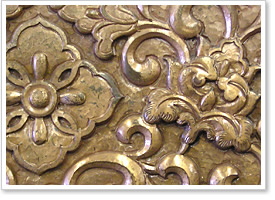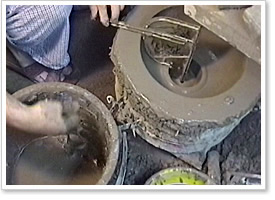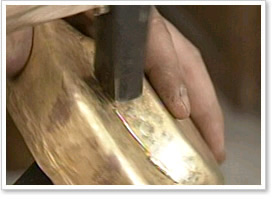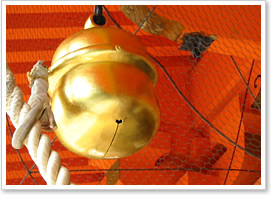Metal carving(“cho-kin”)
It is said that, among all traditional metal work techniques, “cho-kin,” or metal carving, is the fanciest, most widely applicable, and technically most profound. It is one of the techniques that largely depend on the experience of the craftsman. It refers to the technique of carving and decorating the surface of a material with a chisel called “tagane.” This metal carving technique also includes the addition of decorations by relief engraving, openwork, and enchasing.

Metal casting(“chu-kin”)
This technique called “chu-kin,” or metal casting, has complex processes, which are divided into multiple stages, and is painstaking and time-consuming. It uses the fusibility of metals by heat in shape forming. Most of the processes involve the production of molds, into which melted metal is casted, and the finishing work to carefully grind and polish the rough surfaces of cooled and hardened base metal materials. It may be generally understood that metal casting is the type of work to cast melted metal into molds, but it is actually only a small part of the long metal casting processes. Tea kettles, temple bells, sacred mirrors and others are produced by using this technique.

Hammering(“tan-kin”)
This technique called “tan-kin,” or hammering, is to form shapes by hammering and extending boards, blocks and sticks. By hitting and extending, metal structures become tighter, therefore the advantage of this technique is that it can produce items that are hard, light and corrosion-resistant.

Coloring finish for metal surfaces
Coloring, which is the finishing work done to each art piece, is one of the most important metal work techniques. Although it is “coloring,” not much of coloring is actually done. Perhaps because the lifetime of metal crafts has been thought to be several hundred years, paint that might have caused peel-offs may have been avoided. The coloring normally used for traditional metal work techniques is often based on the color forming on base metals caused by chemical reactions or the burning of lacquor or chemical solutions, and coloring techniques vary from shop to shop and from artist to artist and reflect their individual characteristics and uniqueness. This is actually one of the best parts of metal work art pieces. Most of these unique features in coloring techniques are proprietary and corporate secrets. Typical ones include the addition of a pinkish antique art color to silver items, the painted finish in quiet tones of dark brown on bronze items, and so forth.

Cloisonne(“shippo”)
There are many different kinds of cloisonne (“shippo”) techniques, and “cloisonne” is a generic name for the techniques to burn glazes onto base metals. The glass on the metal surface is melted in a high-temperature kiln and is firmly attached to the surface by cooling slowly. Transparent glazes are usually used, but there is also a type called “mud cloisonne” (“doro-shippo”), which uses white glazes.

Inlay(“nunome-zogan”)
In inlaid work, “nunome-zogan” (fabric-mark inlay) is a kind made by placing a burin against the iron surface to cut crisscross lines resembling those in fabrics. A thin sheet of pure gold or fine silver is placed over this and hammered into the engraved lines to produce a pattern.
